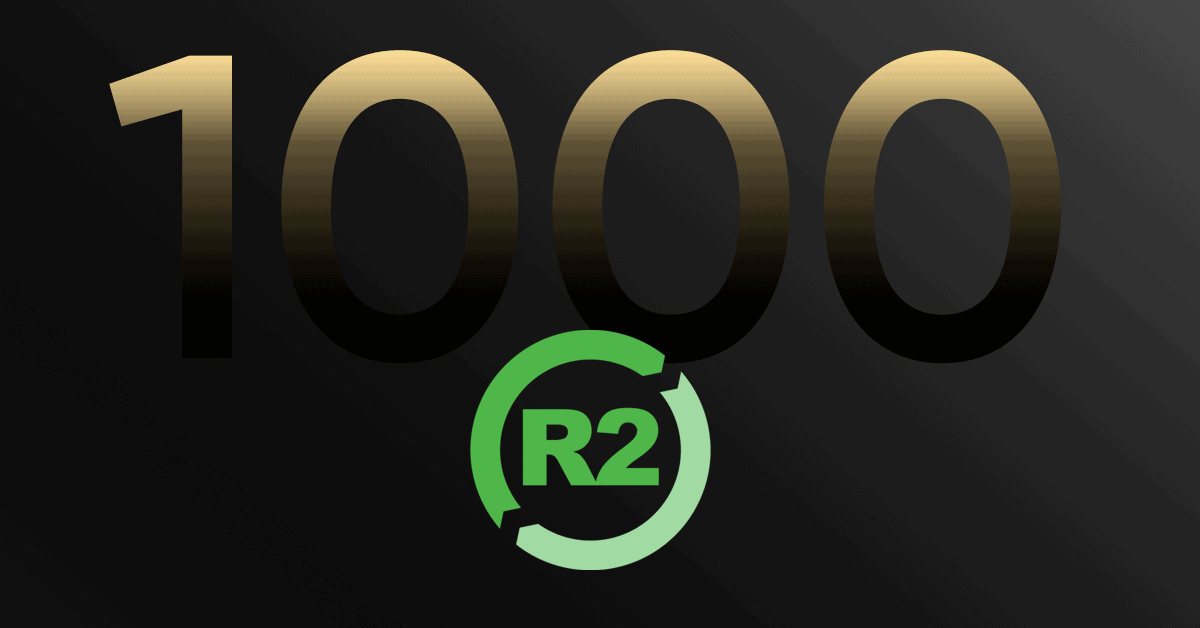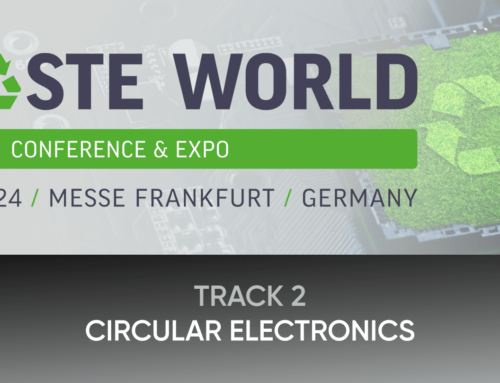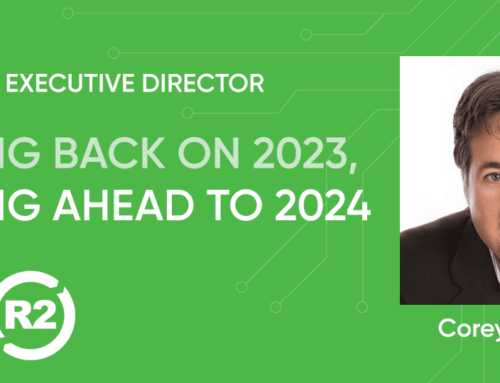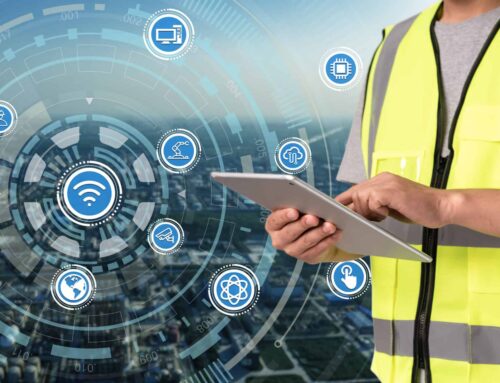Though R2 has flirted with the 1000 Certified Facility mark throughout the three-year transition to R2v3, in July 2023, the number of R2 Certified Facilities crossed the 1,000 threshold to stay. To celebrate this milestone, SERI reflects on R2’s impact throughout its development and considers future directions for the standard.
Chaos on the Ponderosa: The Wild West of early electronics recycling
First, we need to paint the picture of the “before time,” before there was R2.
Ask anyone who was involved in electronics recycling and disposal to describe the industry in the early 2000’s, and the term “Wild West” invariably pops up. Before standards such as R2 were available to companies along the electronics supply chain, the sourcing and disposal of electronic devices was largely unregulated. Frameworks for electronics reuse? Almost nonexistent, let alone best practices for how to protect the environment, data, or the health and safety of the workers dealing with these used devices.
With few rules in place and limited awareness about where electronics ultimately ended up after their useful life was considered over, it was hard to separate the well-intentioned but uninformed from the merely indifferent, or worse, the intentional bad actors. Some companies acted as earnest cowboys, pursuing their agenda while doing their best to adhere to the rules of the range. Others behaved more like reckless bandits, seeking their fortune without regard for how their actions would later affect others.
“Before the R2 standard, there wasn’t a source to go to for best practices,” says Robin Wiener, President of the Institute of Scrap Recycling Industries (ISRI) and a past SERI board member.
Regardless of how much anyone knew or cared about the sourcing and disposal of used electronics, unwanted devices (e-waste) were often sent to landfills or exported to developing countries with cheaper labor and less regulations. Electronics do contain valuable materials like copper, aluminum, and gold that are valuable to recover and provide economic opportunity. But they also contain heavy metals and toxins that are hazardous to both human health and the local environment. These included lead, mercury, cadmium, and flame retardants which, if not handled correctly, could cause catastrophic damage to the air, water, soil and human health. Televisions were stripped of valuable copper, but the leaded glass was left to leach into the soil and ground water. Cables were openly burned to recover the copper wire while polluting the air with toxins, poisoning the workers. Circuit boards were heated over open fires to recover valuable chips while volatizing lead solder into the air, creating even more health hazards. Acid baths were also used to strip circuit boards of precious metals. Much of this was done inside people’s homes, poisoning their food, water, and family.
And year over year, the amount of e-waste was growing along with the rapid growth of technology.
Bribing officials to accept hazardous waste was not uncommon. Even seemingly benevolent charity initiatives, such as donations of older electronics, added to the problem, as they often stopped working a short time after they were received and then still needed to be disposed.
In 2005, recognizing that electronics production was on the verge of an exponential increase over the coming decades, the U.S. Environmental Protection Agency (EPA) convened a multistakeholder group to establish the first standard to certify responsible electronics recycling facilities.
The OG R2: Three years in the making
The EPA approached Mike Watson, then Director of Producer Responsibility and Compliance for Dell Technologies, to consult on the project. As one of the first major computer companies to develop robust requirements for their own e-waste management, Dell had tasked Watson with developing a metric for grading the full supply chain of all recycling facilities in the company’s portfolio alongside environmental auditing partner ERM. Dell agreed to let the EPA’s working group use the Dell audit program as the framework for the industry-wide standard, and Watson joined the Technical Advisory Committee (TAC), the multistakeholder group who would go on to develop the Standard and is still a critical part of the R2 development process today.
Environmental lawyer John Lingelbach was tapped to lead the group, which included representatives from the EPA, state regulatory agencies, and non-governmental organizations (NGOs). The different voices, the EPA reasoned, would ensure that the process would be transparent and that no single body would be able to control the agenda.
Lingelbach had consulted with the EPA for many years and was asked to serve as a facilitator of the process for the different stakeholders as the standard took shape. These groups all held strong—and often opposing—perspectives on what the standard should require.
In 2005, a two-day meeting was convened with the full group in Washington, DC, at which point it became clear that crafting a standard that would please all parties would not happen overnight. What Lingelbach and his colleagues on the TAC didn’t know then was that it would take three years—and 64 drafts—to finalize the first iteration.
At last, in 2008, the first R2 Practices was released, with the consensus standard focusing primarily on solving the immediate problem of improper e-waste disposal.
Structure plays in important role in R2’s adoption
There are lots of standards out in the world covering many different industries and products. But two things that the early creators of R2 understood was that to make a real impact, R2 had to create buy-in across many different stakeholders, and it had to be outcomes oriented.
Both objectives were addressed through structure. It’s important to note that there is no one person that can change the R2 Standard. It is the volunteers that comprise a balanced R2 TAC that regularly meets to consider the Standard and it is this group that ultimately makes any changes or revisions. The TAC is intentionally built to equally represent 3 different stakeholder groups – electronics reuse and recycling facilities, their customers, and a combined group of regulators, academics, and other interested parties. It is this combination that serves as a check-and-balance tension to ensure the Standard considers all perspectives and stays a powerful tool for the entire industry.
Another key feature of the structure is that while the TAC maintains the Standard, independent Certification Bodies and their auditors are who determine if a facility meets the requirements for R2 Certification. This separation of duties reduces conflicts of interest and establishes accountability, which is what creates confidence that an R2 Certified Facility really does follow best practices when handling used electronics.
And so, with this structure, Certifications began to trickle in.
Rike Sandlin, currently the CEO of the environmental consulting firm Rivervista Partners, was an early adopter of R2 at an industry leader, Intechra. He went on to co-chair the TAC that developed that second version of R2 (2013). At first it was a challenge, he says, to persuade facilities that certification was in their best interest. From its inception, gaining R2 certification was a rigorous process, requiring facilities to demonstrate that every link in their supply chain met the criteria for responsible e-waste handling. This often meant hiring consultants to implement new processes as well as auditors to confirm that the changes had been executed.
Sandlin recalls being able to count the number of certified facilities on one hand, then celebrating the day he suddenly needed two hands.
“Every certification was a win,” he says. “We knew we were at the beginning of a whole framework. It was exciting to see the successes happen.”
An executive order shines light
In the USA in 2009, the Obama Administration boosted R2’s visibility by issuing an executive order calling for the creation of an interagency National Strategy on Electronic Stewardship. The Strategy mandated that e-waste from federal facilities could not be disposed of in landfills, and that federal agencies prioritize the reuse of electronics where possible and choose only third-party Certified Facilities for recycling e-waste. Since the federal government was the largest single consumer of electronics in the country, this order made a huge impact.
“Getting to that point took years,” says Sandlin.
R2 Solutions, SERI’s precursor, was founded in 2010 as an independent body to administer the R2 Certification program and continue to develop revisions to the R2 Standard, with Lingelbach as executive director. Over the next several years, R2 Solutions began to see an uptick in certifications from refurbishing facilities as well as recyclers. By 2012, roughly 130 facilities had become certified.
R2:2013: Setting the stage for SERI
As certifications continued to tick up, the TAC determined that it was time for a revision to R2 that would provide a better framework for responsible electronics reuse, not just recycling. There was a growing need for used electronics—particularly computers for home and school use—both in the United States and internationally. But making such a shift work would require reliable data sanitization as well as functionality testing to transport used electronics across international borders.
In 2014, Sustainable Electronics Recycling International (SERI) was founded as a 501(c)(3) nonprofit to continue the responsibilities of R2 Solutions while expanding its mission to include outreach and education efforts for underserved regions around the world. With 600 facilities now certified in 17 countries, it was clear that awareness of the standard had increased worldwide, but greater international adoption would be integral to the success of the organization’s mission.
A global community at loggerheads
Environmental consultant Katharina Kummer-Piery had joined the SERI Board in 2012 after completing a term as the Secretariat for the Basel Convention on the Control of Transboundary Movements of Hazardous Wastes and their Disposal. This multinational agreement was established by the United Nations (UN) in 1989 in response to the growing concern over the ill effects of hazardous waste disposal in developing countries, particularly to burn sites in Africa.
Throughout her career, Kummer-Piery had advocated for finding safe mechanisms for turning waste into usable resources. As the Basel Secretariat, she saw global interest in pursuing actionable regulations for electronic waste gain steam around 2010 due to growing awareness that e-waste was the fastest growing waste stream in the world.
At the same time, she also registered enduring skepticism about how to separate potential beneficial materials from dangerous substances that could not be processed safely. Many members held firm in their view that e-waste should not be allowed to cross borders under any circumstances because the risk was too great that illicit materials would slip through, disguised as beneficial resources.
Environmental consultant Rick Goss, who joined the SERI board in 2014 and is now its chair, had been a member of the TAC that developed the first version of R2. He has also been a frequent negotiator in government policy talks surrounding the international transfer of e-waste, including at the Basel Convention.
Like Kummer-Piery, Goss had a front-row seat to the tug-of-war between those who advocated for reducing the barriers to responsible international e-waste transport and those who championed keeping such barriers in place to protect communities in developing countries from bad actors.
Then and now, Goss notes, the conversation has been further stymied by the fact that other global trade problems are perceived as more dire. He points to the example of the Port of Rotterdam, the busiest trade port in the world. Although it operates under strict controls for responsible e-waste transfer, he explains, it’s still “a sieve” for shipments going to West Africa because inspectors are occupied with searching for evidence of human trafficking, as well as drug and weapons transport.
Kummer-Piery has witnessed this phenomenon as well.
“I’ve never come across a politician at any level who in their campaign would have said, if elected, they would invest in waste management,” she says, noting that issues with greater immediate visibility often take priority when it comes to a government enforcing regulations.
A sustained expansion effort
Having a board that believed in the urgency of promoting R2 Certification—despite such complexities—kept the SERI board and staff focused on their goal of achieving wider global adoption of the standard.
“The EPA chose electronics because it’s such a high-volume industry,” Goss says, reflecting on the initial impetus for creating R2. The agency had foreseen that failing to effectively regulate such a rapidly developing industry would result in devastating environmental damage and human rights violations, a threat that would only escalate as the industry grew.
Watson’s continued participation on the TAC also served as a reminder that Dell’s strict standards for domestic and international e-waste regulation—those on which R2 was initially modeled—had only made the company more successful.
“You have to look at your business and answer very hard questions,” Watson explains of the R2 Certification process. “If you don’t have the right answers, your business isn’t as efficient as it could be. If you can answer yes to 99% of the questions, you’ve optimized your business,” he says, which helps you quickly recoup the investment you’ve put into becoming R2 Certified.
R2v3: Toward circularity and beyond
Upon Lingelbach’s retirement in 2018, Corey Dehmey was hired as SERI’s next executive director. With an extensive background in IT and reverse logistics, Dehmey had helped the US Navy refresh and sanitize the data on 350,000 decommissioned computers and had built R2 processes for electronics recyclers. Lingelbach had brought him on as a consultant for SERI in 2011, to write the R2:2013 version with the TAC. In 2015, Dehmey was hired as SERI’s first R2 Director, so he was well-informed on the latest developments concerning the standard.
Launched in 2020 under Dehmey’s leadership, the third version of R2 (R2v3) represented an ambitious expansion of scope. In the fifteen years since the EPA first called for the standard, the global electronics landscape had transformed utterly. Electronic devices had proliferated wildly, and digital components were making their way into nearly every part of daily life.
The third version of R2 needed to not only be able to adapt to the next round of new technology—whatever that might look like—but also instill a sense of urgency about the need to harness the remaining value of the tsunami of electronics already overwhelming the planet. It would also need to better reflect the diversity of business models and the global nature of facilities who process used electronics.
“R2 has been the cohesive glue in the migration from the linear economy to the circular economy,” Dehmey says, noting that businesses wanting to hire only Certified Facilities have been the primary driver of the surge in certifications.
“R2v3 has broken the mold,” says SERI board member Paul Walker, noting that earlier versions were seen as relevant by certain types of facilities, whereas he believes R2v3 will continue to gain more traction across the market. Walker has found that the most recent version of the standard has been easier for some facilities to adopt, despite the high bar it sets and its broader reach.
Walker is the senior director of the North American Headquarters Customer Service Division at Samsung, and he brought over three decades of experience working in nearly every part of the wireless industry.
“My belief is that version 3 is less of a heavy lift in terms of compliance,” he says, pointing to the example of CC3 Gadget Lab, a Samsung partner company that adopted R2v3 from scratch in just six months. Walker says that the guidelines were so straightforward that the company was able to use their internal team to interpret the requirements and implement programs to meet them, rather than having to hire outside consultants.
Reflecting on the standard’s evolution from version 1 to version 3, Kummer-Piery feels that R2 “has really developed with the times. The circular economy is a recent phenomenon, and SERI really moved with these developments. It goes a long way in putting this into operation rather than it just being a theoretical concept. The way the standard has developed really supports that.”
What 1,000 means
The 1,000-facility milestone boggles the minds of some of those who helped forge its first iteration. “Never did we believe at the onset of the journey that we would have this outcome in under 20 years,” says Watson, who served on the TAC for all three versions and is now a SERI board member.
It might seem that this jump in Certifications could be explained as part of an overall sea change concerning the desire to be seen as “green” in the marketplace. With nearly every major corporation publishing a sustainability report and running ads that highlight eco-friendly initiatives, it can be hard to discern which actors are truly committed to comprehensive sustainability and which are merely making token gestures.
But facilities that hope to hide behind a scrim of greenwashing rather than doing the real work to reform their processes won’t get far with R2. SERI has worked with Certification Bodies to revoke Certifications for facilities that do not meet the required criteria for Certification. The standard was designed so that only auditable criteria were included. “You have to turn each question into a yes or no, taking the subjectivity out of the program,” explains Watson. And the process doesn’t end when certification is granted: facilities are monitored regularly to ensure that they remain compliant.
Reaching the 1000-facility benchmark shows, above all, that R2 Certification just makes good business sense. Certification is increasingly seen as a prerequisite for being competitive in the marketplace, particularly in sectors where proper data sanitization is paramount.
“De-risking is a prime differentiator,” Goss says, noting that to be competitive today, any manufacturer must be able to demonstrate data destruction. “I can’t imagine a business or government entity that doesn’t hold the proper certifications.”
As Watson notes, “The true customer of R2 is the one that buries R2 in their RFP and requires that level of certification and performance as part of a vendor’s capability.” Like the 2009 executive order, this structural imperative gives recyclers the incentive to become certified, knowing that it will result in more customers.
In Sandlin’s experience, it’s usually a market-driven goal that spurs a facility to become certified, but the benefits include being perceived as a good citizen. “They invest to win new business, but the side effect of the investment is that they’re keeping employees safer, protecting the environment, and keeping data safe. It’s exciting that we’re raising the bar,” he says.
“The Wild West hasn’t totally disappeared,” he continues. “There are still snakes, but the landscape of the industry has absolutely shifted. It’s recognized that to be a professional in the business, you’re going to have to be certified.”
“I’m pleasantly surprised at the 1,000 milestone, especially because there seems to be some momentum,” says Kummer-Piery. “The recent agreement with NABCB (an Accreditation Body based in India) is even better news,” she says of work being undertaken to help demonstrate how R2 works within the newer Indian national regulations and better align certification costs with local economies, a project on which Lingelbach is currently consulting. “It has to really work around the globe.”
Wiener agrees that one of the chief values of R2 is its role as a global standard, not just a US standard. “The industry benefits from the consistency of the global environment,” she says, “and SERI has done a great job getting the word out.”
“R2 is critical to the success of the industry,” she adds. “Certification provides an opportunity to show that you’re in the forefront of operating in an environmentally responsible manner. It’s a wonderful message to send to your customers.”
What’s next
Going forward, SERI is working to further global adoption of the standard, as well as further expand the sectors in which electronics might be certified. Dehmey hopes that the organization will not only further the circularity of the global economy for electronics but also boost sustainability by getting the maximum use out of existing electronics.
He notes that the COVID-19 epidemic served as a “forced exercise that created confidence in used products.” Because of supply-chain delays, it was more difficult to buy new electronics, so more people made do with devices that used to belong to a relative or bought them gently used.
An economy that includes repaired cell phones and computers as a trusted alternative to new and refurbished devices, however, must be able to transport the devices to their repair location quickly, before the devices become obsolete. There is a particular urgency to repairing a product whose value depreciates quickly.
As Goss puts it, “We’re making high-tech products, not furniture.”
Walker singles out the large amount of waste associated with refurbishing cell phones rather than repairing them on site as a potential area of focus. Particularly during the COVID-19 epidemic, a secondary market for refurbishing cell phones exploded. Although refurbishing may be a more eco-friendly solution for a broken phone than disposal, the process still requires a number of new parts to make the phone acceptable for resale, he explains.
Instead of refurbishing, Walker notes, telecom companies are now exploring creating channels for walk-in, same-day repair service as well as giving customers the option of purchasing a gently used phone rather than sending a phone off for repair. Such solutions could help extend the life cycle of one of the world’s most ubiquitous devices, shifting the needle toward sustainability.
Sandlin suggests that the standard might adapt to address relatively new market sectors such as photovoltaic (PV) panels for solar energy and other electrical grid equipment. In alignment with the EU’s 2002 Waste from Electrical and Electronic Equipment (WEEE) Directive, R2 might also eventually extend to cover appliances and other devices that are increasingly becoming integrated with technology in the Internet of Things (IoT) landscape.
Dehmey says that the current TAC is already anticipating such changes, drafting additions that will address PV panels, and considering electric vehicle (EV) batteries that have been replaced by longer-life alternatives.
***
As Lingelbach reflects on the initial process of drafting R2, he recalls that despite their differences, everyone at the table “recognized you couldn’t affect much change unless you looked at the whole supply chain.” But requiring facilities to bear responsibility for the practices of every link in their supply chain required “a whole mind shift within the industry.”
Lingelbach says that keeping this requirement in the final version of the standard—without knowing how it would be received—is one of the things he’s most proud of. Now, with 1,000 facilities certified and counting, it appears that his leap of faith has paid off.





